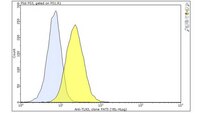The Chaperone UNC93B1 Regulates Toll-like Receptor Stability Independently of Endosomal TLR Transport
Karin Pelka 1 , Damien Bertheloot 2 , Elisa Reimer 3 , Kshiti Phulphagar 4 , Susanne V Schmidt 5 , Anette Christ 6 , Rainer Stahl 5 , Nicki Watson 7 , Kensuke Miyake 8 , Nir Hacohen 9 , Albert Haas 10 , Melanie M Brinkmann 3 , Ann Marshak-Rothstein 11 , Felix Meissner 12 , Eicke Latz
Immunity
48(5)
911-922
2018
概要を表示する
Unc-93 homolog B1 (UNC93B1) is a key regulator of nucleic acid (NA)-sensing Toll-like receptors (TLRs). Loss of NA-sensing TLR responses in UNC93B1-deficient patients facilitates Herpes simplex virus type 1 (HSV-1) encephalitis. UNC93B1 is thought to guide NA-sensing TLRs from the endoplasmic reticulum (ER) to their respective endosomal signaling compartments and to guide the flagellin receptor TLR5 to the cell surface, raising the question of how UNC93B1 mediates differential TLR trafficking. Here, we report that UNC93B1 regulates a step upstream of the differential TLR trafficking process. We discovered that UNC93B1 deficiency resulted in near-complete loss of TLR3 and TLR7 proteins in primary splenic mouse dendritic cells and macrophages, showing that UNC93B1 is critical for maintaining TLR expression. Notably, expression of an ER-retained UNC93B1 version was sufficient to stabilize TLRs and largely restore endosomal TLR trafficking and activity. These data are critical for an understanding of how UNC93B1 can regulate the function of a broad subset of TLRs. | 29768176
 |
Roles of the cleaved N-terminal TLR3 fragment and cell surface TLR3 in double-stranded RNA sensing
Yusuke Murakami 1 , Ryutaro Fukui 1 , Yuji Motoi 1 , Atsuo Kanno 2 , Takuma Shibata 1 , Natsuko Tanimura 1 , Shin-ichiroh Saitoh 1 , Kensuke Miyake
J Immunol
193(10)
5208-17
2014
概要を表示する
TLR3 senses viral dsRNA in endolysosomes. The TLR3 ectodomain is cleaved by proteases such as cathepsins in endolysosomes. It remains controversial whether the N-terminal fragment of TLR3 ectodomain (TLR3N) is cleaved off or remains associated with the C-terminal TLR3 fragment (TLR3C). In addition to endosomes, TLR3 is reported to be expressed on the surface of human fibroblasts, but not of human monocyte-derived dendritic cells. Less is known about roles of TLR3N and cell surface TLR3 in dsRNA sensing. In this study, we show the cleavage site of the TLR3 ectodomain and cell surface expression of TLR3 on mouse primary immune cells. TLR3C, which started at 343S, was associated with TLR3N. Both TLR3N and TLR3C were required for activation of IFN-β and NF-κB promoters by dsRNA, demonstrating that dsRNA is sensed by the TLR3N+C complex. Newly established mAbs to mouse TLR3 revealed that cell surface TLR3 was highly expressed on splenic CD8(+) dendritic cells and marginal zone B cells. Cell surface expression of TLR3 on these cells was dependent on the TLR-specific transporter Unc93B1. Although cell surface TLR3 was only weakly expressed on macrophages, TLR3 mAb specifically enhanced TLR3 responses to dsRNA. These results demonstrate that dsRNA is sensed by the TLR3N+C complex and that cell surface TLR3 is a promising target for modulating TLR3 responses. | 25305318
 |









